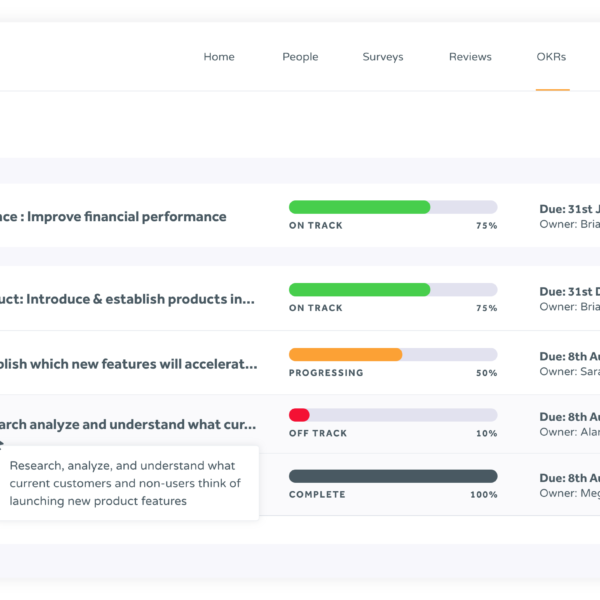During a time when organisations are facing economic challenges and having to re-prioritise their budgets, how can HR ensure they continue to get the most out of their people?

High-quality performance management is essential to gain maximum value from your existing workforce and ensure that everyone is pulling in the same direction. We’ve collected all the key information from our latest webinar with Lucy Adams into an informative guide to help support your performance management strategy.
Performance management guide quick links
Why traditional performance management doesn’t work
Why traditional performance management doesn’t work
Traditional performance management systems suffer from several limitations that render them ineffective in today’s dynamic work environment. One major flaw is the reliance on annual objectives, which quickly become irrelevant by the end of the year. In a fast-paced and constantly evolving business landscape, goals set at the beginning of the year rarely align with the organisation’s evolving priorities or changing market conditions. This misalignment undermines the effectiveness of traditional performance management by rendering the objectives outdated and, consequently, meaningless.
In her latest WeThrive webinar, “A Fresh Approach to Performance Management” Lucy Adams shared that the annual review process is “pointless” and completely inadequate in fostering growth and improvement. Waiting for a whole year to receive feedback hampers employees’ ability to course-correct and make necessary adjustments in real time. Lucy describes this as “worse than doing nothing” because delayed feedback shuts people down and puts them in fight, flight or freeze mode – exactly when we want them to be curious, open and leaning in.
Another practice within traditional performance management that Lucy believes is inherently flawed is ratings. Human beings are subject to biases and individuals’ judgements are influenced by personal preferences, relationships, and other subjective factors. This leads to unreliable and inconsistent ratings, making assessing employees’ true performance and potential difficult.
Lastly, the concept of guided distribution, which assumes that performance follows a normal distribution curve, cannot be applied to human beings. People are not machines; they possess unique strengths, skills, and capabilities that cannot be accurately captured by such a distribution. Imposing a forced ranking system can have detrimental effects, including demotivation, resentment, and a stifling of collaboration and innovation.
What does work?
If traditional performance management systems fall short, what alternative approaches should be implemented? An effective approach is to empower employees to take ownership of their own performance. By reflecting on their motivations to improve, individuals become more engaged and motivated to excel. For example, companies like VistaPrint and River Island encourage employees to seek their own feedback and use their managers as coaches to navigate and implement the feedback effectively. This shift from a parent-child dynamic to individual ownership fosters a sense of autonomy and personal investment in performance improvement.
Another crucial aspect is focusing on teamwork rather than solely relying on 1:1 conversations. Performance predominantly happens within teams, so it makes sense to direct attention towards team dynamics and collaboration. EnPlug, for instance, sets short-term goals for teams and regularly reviews progress in real-time, enabling peer-to-peer feedback and discussions. Similarly, the BBC conducts team-based reviews for their highest-performing units, with the team leader initiating the process by reflecting on their own performance. This creates a psychologically safe environment that encourages open and honest discussions, fostering a culture of learning from mistakes and continuous improvement.
According to Lucy, adopting a process-lite and agile approach can also enhance performance management. By reducing excessive structure and bureaucracy, organisations can shift towards ongoing conversations and feedback. Atlassian, for example, focuses on performance management through weekly check-ins and three key questions, promoting continuous dialogue rather than relying on rigid formal processes.
An emphasis on coaching rather than strict assessment is also crucial for effective performance management. EY, inspired by successful areas of the organisation, found that leaders asking better questions yielded positive results. Instead of traditional training programmes, managers were encouraged to experiment with different questioning techniques to guide and coach their teams effectively. Similarly, Patagonia employs quarterly reviews with a focus on stretch goals. Leaders ask thought-provoking questions that challenge individuals to go further and act as team coaches, creating an environment of growth and development.
These approaches enable organisations to take a less rigid, formulaic approach to performance management that delivers better results for individuals and the business.
Implementing the changes
Business and HR leaders who want to implement a new performance management approach must build a solid case for change. Lucy Adams advises that using relevant statistics can be a useful tool to persuade the board. For instance, she shares that traditional performance management is both time-consuming and costly, with an estimated average cost of £300 per person per year. Furthermore, over 80% of employees do not find it motivating and only 14% of organisations are actually happy with their performance management system.
Highlighting the trend of companies making significant changes to their performance management approaches can further strengthen the case for change. Currently, 79% of executives rate redesigning performance management as a high priority. This demonstrates that organisations are recognising the limitations of traditional methods and seeking more effective alternatives.
Lucy’s top tip for successfully implementing the change is to secure buy-in from early adopters within the organisation. These individuals can serve as a test bed for the new approach, showcasing its benefits and generating support among their peers. It’s also important to understand the reasons behind resistance to change, particularly among late adopters and laggards. By providing a lighter-touch version of the new performance management approach tailored to address these individuals’ concerns or reservations, you can increase the likelihood of successful adoption.
Should we give up ratings?
One central paradox when it comes to giving up ratings is explored by Dave Ulrich. He suggests that there are two extremes when it comes to performance management, and both approaches can have a negative impact. The first is rigorously institutionalising it, and the second is doing away with it completely.

Lucy Adams points out that often organisations raise the issue of distributing bonuses fairly when ratings are eliminated. However, she suggests that currently bonus allocation is based on flawed data and ultimately lacks fairness. By removing ratings, line manager discretion can be leveraged, cutting out the middleman of ratings. Calibration sessions can be implemented to challenge managers and prompt them to justify the amounts they are allocating for bonuses. Taking a gradual approach by testing the judgement and assumptions of a small group of managers, and providing them with a hypothetical budget, can help build their capability and confidence.
Dealing with poor performance should not solely rely on the appraisal process, as it is not designed or equipped to address this issue effectively. Waiting until the end of the year to address poor performance is counterproductive. Instead, more timely interventions and performance discussions can be conducted throughout the year to address performance concerns promptly and provide support for improvement.
Putting it into practice
Traditional performance management approaches often fail to motivate employees. By embracing alternative methods that focus on quality conversations with quality outcomes, individual development, and ongoing feedback, organisations can cultivate a more motivating environment that encourages continuous improvement and growth.
WeThrive’s performance management tool helps organisations to do just that – quickly, easily and effectively. Learn more about our approach to performance management here or book a demo to see the platform in action.





